

Self-Improvement Strategies For Becoming A More Authentic Leader. Our deepest fear is not that we are inadequate.

Our deepest fear is that we are powerful beyond measure. It is our light, not our darkness, that most frightens us. We ask ourselves, who am I to be brilliant, gorgeous, talented, and fabulous? Actually, who are you not to be? You are a child of God. I believe authentic leadership does not come from title, social stature, or the size of one’s paycheck but rather from how you live and the impact you make around you. Harvard Business School professor, former Medtronic CEO, and author Bill George popularized the concept of “authentic leadership” in his 2003 best-selling book Authentic Leadership, which was developed further in his later book True North.
The word “authenticity” comes from the Greek root authentikos, meaning "original, genuine, principal. " Tell Me a Story. Eight tips for creating powerful narratives that drive social impact.
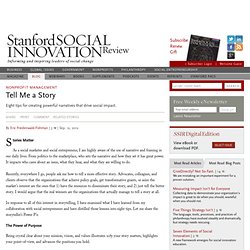
Stories Matter. Tribal leadership. How does it affect your company culture? In under 10 years Zappos grew to achieve a billion dollars in annual gross merchandise sales, while simultaneously making Fortune magazine’s ‘100 Best Companies to Work For’ list.

Success that was driven primarily by repeat customers and word of mouth – something your company probably depends on for cashflow. While their brand has come to be known for delivering excellent customer service, their priority is surprisingly not customer service – it’s cultivating company culture. Zappos believe if they get culture right, most of the other stuff – such as delivering great customer service or building an enduring brand or business – will happen as a natural by-product of the culture. They’re serious, even offering to pay new employees 5K USD if they chose to leave within the first 6 weeks – if the culture doesn’t fit.
How To Be More Interesting (In 10 Simple Steps) Building a Learning Organization. The Idea in Brief As we all know, to stay ahead of competitors, companies must constantly enhance the way they do business.
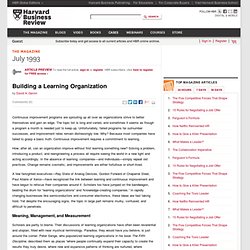
But more performance-improvement programs fail than succeed. Make Learning Matter: Become a Learning Organization. Organizations with the best chance to succeed and thrive in the future are learning organizations.
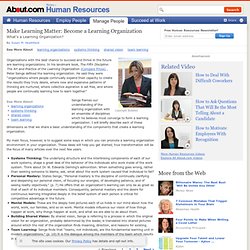
In his landmark book, The Fifth Discipline: The Art and Practice of the Learning Organization (Compare Prices) , Peter Senge defined the learning organization. Untitled. Prasad Kaipa, Ph.

D. The leader's new role in the knowledge age is to encourage people to think from their heads (to unleash their creativity), feel from their hearts (to create a culture of empowerment to nurture themselves and people around them), work with their guts (provide leadership by doing, and practicing what they preach), and integrate their spirit (by focusing on building capacity and appreciative approach to inspire others) in their day-to-day work. This integral, cyclical approach has the potential to create the new wealth--intellectual property --of the organization, tap into the intrinsic motivation of the employees, allow a sense of fulfillment in work, and truly develop an organizational soul that works to a competitive advantage in the internet age. How do you design organizations that learn? You have to develop a learning environment that focuses on competence and capacity building in its people. 1.0 Designing a Learning Environment 1.1 Creating a Foundation.
What is a Learning Organization? - systems thinking, Fifth Discipline, Peter Senge, mentors, chain management, mental modes. Introduction Learning organizations are not simply the most fashionable or current management trend, they can provide work environments that are open to creative thought, and embrace the concept that solutions to ongoing work-related problems are available inside each and every one of us.
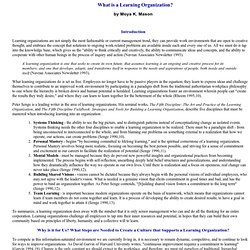
All we must do is tap into the knowledge base, which gives us the "ability to think critically and creatively, the ability to communicate ideas and concepts, and the ability to cooperate with other human beings in the process of inquiry and action (Navran Associates Newsletter 1993). Decisions are taken more democratically with a higher percentage of women in management positions. In workplaces with a high percentage of women in a management position more individualized employee feedback is carried out, more democratic decisions are adopted and more interpersonal channels of communications are established, according to a study by the Universidad Carlos III de Madrid.

The Future of Academic Libraries, An Interview with Steven J Bell. First, Let's Fire All the Managers. Management is the least efficient activity in your organization.
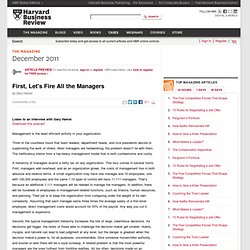
Think of the countless hours that team leaders, department heads, and vice presidents devote to supervising the work of others. Most managers are hardworking; the problem doesn’t lie with them. The inefficiency stems from a top-heavy management model that is both cumbersome and costly. A hierarchy of managers exacts a hefty tax on any organization. This levy comes in several forms. Second, the typical management hierarchy increases the risk of large, calamitous decisions. Third, a multitiered management structure means more approval layers and slower responses. Finally, there’s the cost of tyranny. Hierarchies Versus Markets No wonder economists have long celebrated the ability of markets to coordinate human activity with little or no top-down control. That’s why we need corporations and managers.